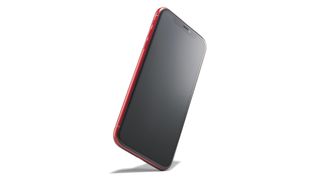This year's cheaper iPhone feels anything but budget. A class-leading camera, premium build and top-tier speed make it a Ferrari in sheep's clothing Apple iPhone 11
(Image credit: Future)
Best Review
The iPhone 11 strikes a brilliant balance between features and price. You wouldn't know it's the cheaper of Apple's 2019 phones from its build, camera, and speed. If only it had an OLED screen…
REASONS TO BUY
+ Superb dual-lens camera
+ Blazingly fast
+ Great battery life+ Lovely design and build
+ Impressive audio
REASONS TO AVOID
- No zoom lens on the camera- LCD screen not as good as OLED for movies
- Only comes with 5W charger
Welcome to Best Review iPhone 11 review, taking a look at the iPhone you’ll probably buy this year.
Now we’ve got its little sibling, which sells for a whopping £300 less, yet only really feels cut back in minor ways. You have a top-tier dual-lens camera, lush 6.1-inch screen, sleek glass, and metal design, next-gen Face ID security, the most powerful phone processor on the planet and a big battery life… it’s a seriously great package.
And you can land that package with a discount by bagging a great Black Friday deal. Be sure to browse around right now, as there are some serious scores to be had.
IPHONE 11 REVIEW: PRICE AND DESIGN
(Image credit: Future)
The iPhone 11 starts from £729 – a full £320 less than the £1,049 iPhone 11 Pro. That’s for a 64GB model, which is the same capacity as the Pro models come with Apple iPhone 11.
You can upgrade to 128GB of storage for £50 more, and we would absolutely recommend that. 64GB is actually fine for most people, but that upgrade price is so meager (especially if spread out over monthly payments) that it seems like a slam dunk to us.
There’s also a 256GB option for £879 if you want even more space. Apple continues to avoid putting microSD card slots on its phones, so whatever amount you choose is what you’re stuck with Apple iPhone 11.
The iPhone 11 comes in six colors, lots of which are new. There are black, white and red tones, which are familiar from the iPhone XR range that this sort of replaces (the XR is still around, but is now cheaper).
The new colors are yellow, green and purple. These last three are actually all a bit paler than it seems on the Apple website – because the back is glass, the colors can really turn pastel in the light. The purple, in particular, is much more of light lilac.
It’s a great range of shades, though – we’re just glad so many companies are embracing phone design outside of black and off-white.
Apple says the iPhone 11 models have the “toughest glass ever in a smartphone”, which you’ll find on the back and front. Unlike the iPhone 11 Pro, there’s no etched pattern on the rear glass, so it’s totally smooth Apple iPhone 11.
The sides of the iPhone 11 are aluminum, compared to stainless steel in the 11 Pro – that’s the kind of cost-saving we can definitely live with.
On the front, the iPhone 11 has marginally thicker bezels than the iPhone 11 Pro, but it still feels like a modern design. There is a big notch, which is slightly less up-to-date, but unless you’ve got a serious tech fetish, it’s really not something that will bother you in any way. It needs to be big to house all the tech for Apple’s Face ID system, which is more secure than in other smartphones.
The fit and finish are full of Apple quality – there’s no sense that any cheaping out has happened in the construction. It feels just as solid and near-seamless in the hand as the more expensive model… it’s just made from slightly less fancy materials in some areas.
IPHONE 11 REVIEW: SCREEN AND SPEAKERS
The screen is one of the big differences on the iPhone 11 compared to the 11 Pro. Here, you’ve got a ‘Liquid Retina’ LCD display (which is just Apple’s way of saying it’s a very nice LCD with curved corners); on the iPhone 11 Pro, you’ve got high-end OLED screen.
The display is 828x1792, which makes it fairly low-resolution compared to a lot of rivals, but with a pixel density of 329ppi, it’s still easily sharp enough to look great. Once you go beyond 300ppi (which the same sharpness as photos in a magazine, for example) you’re really into diminishing returns. The text is clear, photos are sharp. HD movies have a little softness to them when compared to the 11 Pro side-by-side, but it’s small.
The big limitation here is that it’s LCD, compared to OLED screens in basically all of its rivals, as well as the 11 Pro. OLED gives you better contrast between light and dark areas on the screen and works better for displaying HDR.
The iPhone 11’s screen isn’t HDR-rated at all and has a maximum brightness of around 625 nits. The iPhone 11 Pro’s screen works with Dolby Vision (the most advanced kind of HDR) and peaks at around 1,200 nits – that’s pretty much what you expect from an OLED TV.
Side by side, the difference is noticeable, especially when watching HDR movies – there’s a relative flatness to the images on the iPhone 11 compared to the 11 Pro. The colors look great, but it doesn’t have the realism and nuance that the extra dynamic range of the OLED screen gives you, especially in scenes that contrast light and dark strongly Apple iPhone 11.
The same is actually true for HDR photos – looking at the same shot on both the 11 and 11 Pro reveals darker detail on the 11 Pro, making everything look moodier and more dramatic. Though whether you prefer that might be more of an aesthetic thing – there’s nothing wrong with the pics you’re seeing on the iPhone 11’s screen.
In other areas, the difference is minor to the point of being not really worth mentioning. Web browsing, social and other apps all look fine. Better than fine, in fact – Apple has included a wide P3 color display that makes photos look vibrant and realistic when taken on the phone.
It also includes Apple’s True Tone tech, which adjusts the color balance depending on ambient light, making it much more comfortable to read. We can’t overstate how great this feature is – you don’t notice it until you have to use a screen that doesn’t have it, and the nasty blue hue overwhelms.
Speaker of color balance, the screen is noticeably less warm-toned than the iPhone 11 Pro’s OLED display. It’s not that the whites look blue here – they definitely look white. It’s more than we noticed the whites on the 11 Pro feeling just a tad yellower.
The 6.1-inch size of the display is excellent. It’s on the borderline of what I can comfortably use one-handed (I’m a fairly large man, though), but it feels like it’s giving you lots of space. It’s almost a shame that this size isn’t available in the higher end models (which come in 5.8-inch or 6.5-inch only).
Ultimately, the screen is great, but movie lovers would probably prefer an OLED model. You can get that from Apple’s Pro phones if you want to stick with iOS, or from any number of Android rivals – the best phone for movies is Sony’s Xperia One if you’re that keen.
Apple’s new spatial audio tech, also seen on the Pro models, is used here – it’s really impressive at creating a stereo sound that also hints at even more precise positions of 3D audio. Generally, we suspect most people who watch movies on the phone will use headphones, so it may not get to fulfill its potential that often, but the fancy speaker arrays come with a second bonus: they’ve very loud and pretty damn good.
Music sounds great from the iPhone 11 directly, as do podcasts. Very clear, a pretty good and rich balance, and you have to go pretty damn loud to make it start to feel harsh. They’re impressive!
IPHONE 11 REVIEW: CAMERA
The iPhone 11 has a dual-lens camera system, consisting of a wide-angle lens that’s pretty much the same as found on the iPhone XR last year, but now with an ultra-wide-angle lens to back it up.
The ultra-wide lens is 0.5x zoom compared to the wide-angle, so it effectively lets you zoom out without having to move your feet – great for landscapes, indoor shots, groups, and architecture.
It’s used here for more than just extra angles here, though. It can do 3D depth sensing, meaning that the iPhone 11 has proper Portrait mode – the version of this feature on the iPhone XR was all done with software, but here it’s done with actual 3D data. This means it works on people, pets, and objects (the XR’s only works on people).
It also helps with the new Night mode feature, which captures extremely low-light images, and is a small revolution. Quite a few other phones have debuted with similar features, stretching back to the Google Pixel 3 last year, but Apple’s is the best implementation yet – it not only brightens images without making them noisy but also adds loads more detail in Apple iPhone 11.
It’s a game-changer, especially given that it’s extremely easy to use (but you can tinker with its settings once you’re confident about using it).
The image quality from the 11’s cameras is just fantastic and is as good as you get from the iPhone 11 Pro, albeit without the third 2x telephoto lens (which does reduce flexibility somewhat). That’s the headline: the pictures are as good as £1,000 phones – and that includes Samsung as well as Apple).
The rich HDR brings brilliant drama to skies, and realistic shadow and highlight contrast in sunny scenes. There are bags of detail, but Apple does a good job of not letting processing overtake the shot – scenes look how they should as if a high-end dedicated camera was taking the shots.
On the front, you’ve got an improved selfie camera that now has a wider field of view, though you can choose how wide you want it to be: narrow for just yourself, or wider for a group.
The only complaint we have at all about the iPhone 11’s cameras is that you get much more flexibility from a triple system – either one like on the 11 Pro, or especially on the Huawei P30 Pro, which is more expensive (though not by much), but gives you a 10x digital/optical hybrid zoom that’s practically full quality.
The pure image quality is better from the iPhone 11, but there’s no denying that a good zoom can let you get more artistic about framing.
Speaking of framing, Apple has included an optional extra trick in the iPhone 11 models that’s worth mentioning: composition correction. In the Settings app, under Camera, there’s a new switch for ‘Photos Capture Outside the Frame Apple iPhone 11.
Turn it on and it will start using the ultra-wide angle camera to monitor what’s just outside the frame you shoot when you’re using the regular wide-angle. If it thinks there’s a slightly better composition to be had (for example, correcting a slightly off-straight shot, or better centering a subject), it will pull in extra pixels from the ultra-wide camera and instantly reframe the photo. You’ll never even know it did it, you just think you take a great shot.
Obviously, this could override your intentions, which is why it’s an optional extra, and in any shots that have the adjustment applied, it can be removed in the Edit mode with a single tap.
Obviously, this could override your intentions, which is why it’s an optional extra, and in any shots that have the adjustment applied, it can be removed in the Edit mode with a single tap.
It’s a very clever, and potentially really useful addition for people who just want nice shots and don’t study the artistry of it.
Let’s take a look at some sample images:

Left: Ultra-wide lens. Right: Wide lens.
(Image credit: Future)
Here, you can see a shot taken with both lenses, and how it changes the view. Note how similar the colors are between the two images – the lenses have been carefully calibrated so they’ll give the same results.

Left: iPhone 11, wide-angle. Right: iPhone 11 Pro, telephoto
(Image credit: Future)
Here’s the difference between the Portrait mode shots you can get from the wide-angle lens on the 11 versus the telephoto lens on the 11 Pro. To make sure I was the same size in both shots, I stood further away for the shot on the 11 Pro. You can see how it drastically changes the background field of view, which sometimes you’ll want, sometimes you won’t. (Bear in mind that on the 11 Pro, you could have taken either of these shots, because it can do Portrait mode from multiple lenses).
When viewed full size, you might also notice that the iPhone 11’s shot actually has more detail, especially in the material of my jumper, and around my stubble. The wide-angle lens is likely able to pick out the detail better because more light gets into it than through the telephoto lens.
That said, the telephoto shot has a more convincing depth of field effect around my hair.

iPhone 11, wide-angle lens
(Image credit: Future)
There’s nothing special about this pic in itself, other than that my cat has an adorable bow. The interesting this is that this pic got taken /at all/: the cat was walking towards me to bump her head on the camera, and somehow I was able to bring up the camera, focus, and Portrait mode did its thing in time. There was, I would say, a quarter of a second at most for this.
Any older iPhone simply wouldn’t have been capable of a) getting all that done in time, and b) literally taking this shot at this angle, because these are the first iPhones that can do Portrait mode on any subject on a lens other than the telephoto. So yes, this shot is a tad blurry because she’s moving, and it ain’t art… but it exists!

Left: Night mode turned off. Right: Night mode
(Image credit: Future)
We’ve abandoned glamour for our Night mode comparison because we wanted to get gritty and realistic – this is from the corner of a garage that light pretty much just doesn’t reach, so whatever Night mode does is the best you can hope for. It’s also great for showing how the mode lifts detail from nowhere.
The wall goes from being a smeary patch of pixels to something with actual texture, and the black shade in the bottom corner suddenly becomes a floor. The broken light has tons more detail to it, and obviously, the overall look is massively boosted.
Night mode works by taking a longer shot – the exact length depends on how dark it is and how shaky your hands are, with the iPhone automatically adjusting as needed – and is set to just jump in automatically when it’s needed.
If you can rest the iPhone, or even use a tripod, you can set the length up to 30 seconds (our shot above was three seconds), which is capable of producing some incredible starlight shots.
If you can rest the iPhone, or even use a tripod, you can set the length up to 30 seconds (our shot above was three seconds), which is capable of producing some incredible starlight shots.
The iPhone 11 is top-end when it comes to video, too. Apple’s 4K footage is absolutely fantastic, the extended dynamic range of the sensor producing incredibly colorful footage with detail in everything from highlights to shadows.
But the biggest win is the image stabilization, which makes hand-held footage look like it’s from a gimbal. It means that everything stays much crisper, and will even try to prioritize the subject, subtly making sure they stay as close to the center of the frame as possible.
When footage isn’t shaky, it comes out sharper – it elevates the quality here dramatically.
IPHONE 11 REVIEW: PERFORMANCE AND BATTERY
The buzzing heart of the iPhone 11 is Apple’s A13 processor, which is the newest and fastest processor from the company that already made the fastest processor last year, and has yet to be bested.
This means the iPhone 11 is a screamer when it comes to speed – everything is instant. Some of this is down to iOS 13 speeding up some key parts of the software on all devices, and some of it is down to the new chip, which is 15-20% faster than last year’s iPhone XS, depending on the task.
Processing power is not something that phones tend to lack in these days – even mid-range Android models regularly have beefy chips that are only just behind the top-end models, if they’re really behind at all iPhone 11 review.
But it’s still great that’s Apple cheaper model absolutely does not feel cheaper in this vital measure – there’s no penalty in the experience at all for saving yourself a few hundred quid.
One of the key new elements of the A13 is a much improved neural processor, used for the camera processing trickery (among other things), and again it’s great to be able to feel this power when you’re using the camera – you might not have as many lenses as an iPhone 11 Pro, but you still get the incredible response time of the Portrait mode (as mentioned above) and the full power of Night mode.
geekbench BENCHMARKS - APPLE IPHONE 11

(Image credit: GeekBench)
GeekBench 4
Battery benchmark: 4084
CPU single: 5474
CPU multi: 13962
GeekBench 5
CPU single: 1333
CPU multi: 3470
Apple’s strongest graphics chip is also in the A13, and given that the iPhone was already pretty much the most powerful handheld gaming device even without any kind of special gamer-focused features, this keeps it ahead of the game (especially with Apple Arcade turning out to be a hell of a great range of games for ridiculously cheap price).
Apple has focused on reducing power usage with the A13 this year, though the iPhone 11 benefits more subtly than the Pro models. The larger battery in the iPhone 11 Pro Max has made it the best phone for longevity this year, while the iPhone 11 comes in second – last year, those positions were reversed, with the iPhone XR beating the iPhone XS Max. In both years, the 5.8-inch iPhone comes third.
But still, we’re talking really great longevity from this model, which again means you’re not getting short-changed if you don’t want to spend Pro money. For light users, you can get through two days.
Heavy users will definitely have battery left at the end of the day, assuming you don’t literally play Fortnite non-stop.
Heavy users will definitely have battery left at the end of the day, assuming you don’t literally play Fortnite non-stop.
Apple still ships the phone with a 5W charger, which is just cheap at this point. The Pro models come with an 18W charger, and I really feel that this should be standard. It can charge faster if you use higher-power adapters, though. There’s also wireless charging.
One other small area that’s been sped up is Face ID recognition – a new version of the tech makes it slightly faster and slightly more reliable. It’s not game-changing, but it’s welcome iPhone 11 review.
IPHONE 11 REVIEW: SHOULD YOU UPGRADE
If you have an iPhone 8 or earlier, I think this is the ideal upgrade model – especially if you’ve got one of the earlier phones. Everything about the 11 is better than what came before – you’re going to get a huge jump in speed, screen quality, camera capability, and design.
If you have an iPhone X, I think it’s a tougher call. You’ve got better battery life and an improved overall camera system here (you’ll be trading your telephoto lens for an ultra-wide, which a question of preference as much as anything) that includes Night mode – and those alone might be enough.
There are also lots of small quality-of-life improvements, including a little bit of extra speed (not that the X is a slouch now), new speakers, better wireless connectivity and faster Face ID.
But you’ll be swapping your lovely OLED screen for a slightly less rich OLED one – though it’ll be bigger. Personally, I’d be keen to upgrade to the 11 over the X mainly for the camera, but I don’t think you’d be mad to hold off another year.
There are also lots of small quality-of-life improvements, including a little bit of extra speed (not that the X is a slouch now), new speakers, better wireless connectivity and faster Face ID.
But you’ll be swapping your lovely OLED screen for a slightly less rich OLED one – though it’ll be bigger. Personally, I’d be keen to upgrade to the 11 over the X mainly for the camera, but I don’t think you’d be mad to hold off another year.
For iPhone XR owners, it’s especially tough. You can get nearly the same phone, but with almost every part improved a little bit, including the ability to use Portrait mode for subjects other than people, and the second ultra-wide lens, plus Night mode, of course. I suspect most people won’t see it as being worth the upgrade cost this year, but I wouldn’t blame you.
Those who have an iPhone XS should probably only look to the iPhone 11 Pro for an upgrade, or hold off. You’ve already got dual cameras (though again with a telephoto instead of ultra-wide) that perform close to what the 11 is capable of (excluding Night mode) and a much nicer HDR screen. The 11 would be a sideways move – the 11 Pro would be an upgrade.
One last mention for iPhone SE owners: the iPhone 11 being the cheaper of the new phones will make an obvious candidate for those looking to move on at last, but bear in mind that it’s pretty large. Purely on its own terms, it’s a fantastic upgrade, but if the size is a concern, give serious thought to spending the extra on the smaller 5.8-inch iPhone 11 Pro.
IPHONE 11 REVIEW: VERDICT

(Image credit: Future)
This is all about the balance. The balance of cutting back features to make it over £300 quid cheaper than the iPhone 11 Pro, but without making it feel anything other than a high-quality Apple product.
And the short answer is Apple has balanced better than Simone Biles. It feels like a top-tier handset in almost every way, from the build quality in your hand to the camera quality to the sheer slickness of using iOS.
The only areas where it falls a little short are the lack of HDR screen for movies, and that there’s no zoom lens at all, so you don’t get the same flexibility as the iPhone 11 Pro (or the slightly more expensive Huawei P30 Pro).
In every other way, this is a massively impressive phone and is the iPhone that most people should buy this year.
Many thanks to Vodafone for supplying a device for review. Vodafone's full Samsung Galaxy S10 range can be viewed on its official website.




0 Comments